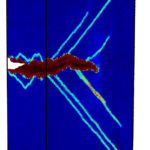HPC User Report from P. Baranova (Chair of General Materials Properties)
MD Simulations of Cracks in Heterogeneous NiAl
Molecular Dynamics simulations were performed to study the influence of heterogeneities on the fracture behavior of brittle intermetallics. Heterogeneities were created at both the atomistic and the mesoscale by varying the composition non-stoichiometric of B2 NiAl and by adding voids.
Motivation and problem definition
The fracture of (semi-)brittle solids is strongly influenced by material heterogeneities located directly at the crack front. Through their elastic interactions with the crack front, heterogeneities can accelerate, decelerate or deviate propagating cracks. In addition, the direct interaction of a propagating crack with heterogeneities can lead to (a) local crack front reorientations, which can lead to the activation of slip systems not available to the initial crack front; (b) changes of the crack front configuration, e.g. blunting, which can lead to crack trapping or (c) dynamic perturbations of the crack front, e.g. crack front waves. So far, these effects have not been studied in detail. As fracture is ultimately the result of breaking of atomic bonds, atomistic simulations are ideally suited to study crack – obstacle interactions.
Methods and codes

We employ mostly molecular dynamics (MD) and statics with semi-empirical many body potentials of the embedded atom method (EAM) type. All simulations were performed with the massively-parallel MD software package IMD (ITAP Molecular Dynamics). Relatively large (8-15 million atoms) simulation boxes are required to minimize finite-size effects in the study of propagating cracks, thus making the use of high-performance clusters necessary.
Results
Using PRZE’s Lima cluster, we could increase our sample size and were able to observe crack propagation through heterogeneous material over sufficient distances and time. At the atomistic scale, structural vacancies were shown to facilitate brittle fracture. At the mesoscale, crack propagation could be stopped by the presence of voids by two different mechanisms: the stimulated emission of dislocations and through the variation of the local stress state. These results help to better understand and model the influence of microstructure on the fracture toughness of semi-brittle materials.
Outreach
The project contributed towards the successful ERC CoG proposal microKIc – microscopic origins of fracture toughness and the proposal for a DFG research training group modeling fracture across the scales (FRASCAL). Parts of the project were featured in “Der Herr der Risse: Zerstören für die Wissenschaft”, TV report in Franken-Fernsehen (https://www.frankenfernsehen.tv/mediathek/video/der-herr-der-risse-zerstoeren-fuer-die-wissenschaft-2/ ) and “Sinnvolle Zerstörung”, Nürnberger Nachrichten, 17./18. Juni 2017. The results will be the basis for Ms. Baranova’s PhD thesis and an according journal publication is in preparation.
Researcher’s Bio and Affiliation
Polina Baranova received her Diploma of Specialist (Dipl.-Spec.) in Mechanics at Taras Shevchenko National University in Kyiv/Ukraine. Since May 2014, she is working as a doctoral candidate under the supervision of Prof. Erik Bitzek at the Department for Materials Science, Institute I.
